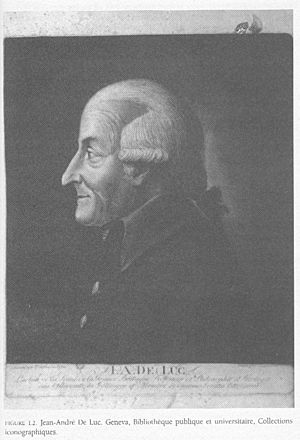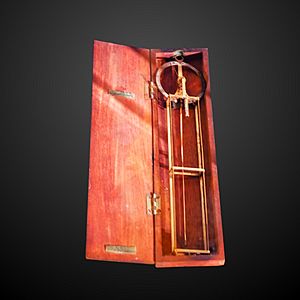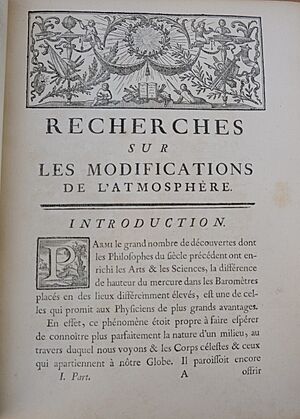Jean-André Deluc facts for kids
Quick facts for kids
Jean-André Deluc
|
|
|---|---|
 |
|
| Born | 8 February 1727 |
| Died | 7 November 1817 (aged 90) Windsor, Berkshire, England
|
| Nationality | Genevan, then Swiss since 1815 |
| Scientific career | |
| Fields | Geology, meteorology |
Jean-André Deluc (born February 8, 1727 – died November 7, 1817) was a clever Swiss scientist. He was a geologist, which means he studied the Earth. He was also a natural philosopher and a meteorologist, someone who studies weather. Besides that, he invented and improved many measuring instruments.
Contents
About Jean-André Deluc
Jean-André Deluc was born in Geneva, a city that was then part of the Republic of Geneva. His family had moved there from Italy in the 1400s. His father, Jacques-François Deluc, was a writer who supported the ideas of Jean-Jacques Rousseau.
Early Life and Studies
As a young student, Jean-André Deluc learned a lot about mathematics and natural philosophy from his teacher, Georges-Louis Le Sage. For many years, he worked in business. However, he also spent a lot of time exploring the Alps mountains and studying science.
With his brother Guillaume-Antoine, he built an amazing collection. It included many different minerals and fossils, which are remains of ancient life.
Deluc's Role in Politics
Deluc also got involved in politics. In 1768, he traveled to Paris to meet the Duke of Choiseul. He became good friends with the Duke. In 1770, he became a member of the Council of Two Hundred in Geneva. This was an important group that helped govern the city.
Moving to Great Britain
Three years later, Deluc faced some business problems. This made him leave his hometown of Geneva. He only returned for a short visit once. This change allowed him to focus more on science. In 1773, he moved to Great Britain.
There, he got a special job as a reader for Queen Charlotte. He held this position for 44 years! This job gave him both free time and money to continue his scientific work.
Even with his duties at court, he was allowed to travel. He visited Switzerland, France, Holland, and Germany several times. During a trip to Germany (1798–1804), he became an honorary professor. He taught philosophy and geology at the University of Göttingen. This also helped him with diplomatic missions for King George III. After returning to Britain, he explored the country to study its geology (1804–1807).
In 1773, Deluc became a fellow of the Royal Society. This is a very old and respected group of scientists. He was also connected with the French Academy of Sciences and other scientific groups. Jean-André Deluc passed away in Windsor, Berkshire, England, in 1817. He had spent almost 70 years doing scientific research. A crater on the Moon is named after him!
What Deluc Discovered
Jean-André Deluc was most interested in geology and meteorology. Another famous scientist, Georges Cuvier, thought Deluc was an expert in geology.
Earth's History and Weather
Deluc's main book on geology was called Lettres physiques et morales sur les montagnes et sur l'histoire de la terre et de l'homme. It had six volumes and was dedicated to Queen Charlotte. He also wrote books about his geological travels in Europe and England.
He noticed that heat disappears when ice melts. This was around the same time that Joseph Black developed his idea of latent heat. Latent heat is the energy absorbed or released during a change of state, like melting ice, without a change in temperature. Deluc also found that water is heaviest (densest) at about 5°C, not when it freezes.
He was the first to suggest that the amount of water vapour in any space doesn't depend on the air around it. This idea was later used by John Dalton.
Deluc wrote another book, Lettres sur l'histoire physique de la terre (1798). In it, he described a theory that the Earth's history could be divided into six periods. These periods were based on the six days of creation mentioned in the Bible. This book also included interesting talks he had with famous thinkers like Voltaire and Rousseau.
Deluc greatly admired Francis Bacon, a philosopher. He wrote two books about Bacon's ideas. One showed how a French translator had left out parts of Bacon's work that supported religion. The other gave a good overview of how natural science was progressing.
He also wrote about Christianity and had a debate with Wilhelm Abraham Teller about the Mosaic cosmogony (the story of creation in the Bible). His book Traité élémentaire de géologie (1809) was written to argue against the ideas of James Hutton and John Playfair. They believed that the Earth's features were shaped by slow processes like heat and erosion, which would take a very long time. Deluc's ideas, based on the biblical timeline, needed much less time.
Many of his other scientific papers were published in important journals like the Journal de Physique and the Philosophical Transactions.
Deluc's Inventions and Improvements
Deluc spent a lot of time making measuring tools better or inventing new ones.
He created a portable barometer that geologists could carry with them to measure air pressure. His book Recherches sur les modifications de l'atmosphère (1772) described his experiments. These experiments were about moisture, evaporation, and how hygrometers (which measure humidity) and thermometers (which measure temperature) work. He also figured out the correct way to use a barometer to measure how high places are.
He invented a new hygrometer that looked like a thermometer. It had an ivory bulb that would expand when it got wet, making the mercury inside go down. Later, he made a hygrometer using whalebone. This led to a big debate with Horace-Bénédict de Saussure, who had invented a hygrometer using hair.
Based on his experiments in 1772, Deluc suggested using mercury in thermometers instead of alcohol. He found that mercury's volume changed more evenly with temperature. This made mercury thermometers more accurate for measuring temperature changes.
In 1809, he sent a long paper to the Royal Society about the dry pile. This was an early type of Voltaic pile, which was a battery that produced electricity. Deluc described an "electric column" and an "aerial electroscope." He had some ideas that went against the newest discoveries of the time, so his paper was not published in the Transactions. Even though he didn't invent the dry pile, his improvements were very important. He was also a valuable mentor to a young scientist named Francis Ronalds.
Science and Beliefs
In his later years, Deluc spent time thinking about how science and religious beliefs fit together. In his debate with Hutton, Deluc argued that Hutton's ideas didn't do enough to challenge atheism, the belief that there is no God.
Deluc tried to connect his scientific observations about the Earth with the Bible's description of the world's history. In his book Lettres physiques et morales, he explained the six days of creation as long periods of time before the Earth became what it is today. He also believed that the great flood mentioned in the Bible happened because cavities inside the Earth filled up with water.
This topic is explored in more detail in a book called Geology and Religion by Martina Kölbl-Ebert.
Images for kids
See also









